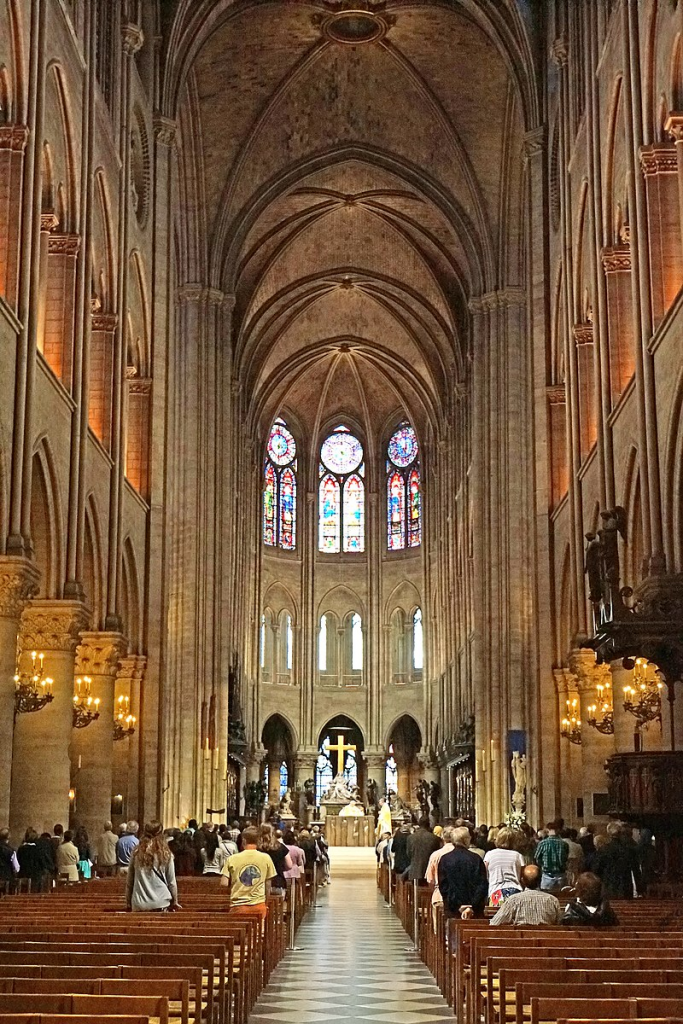Gothic Architecture in France
In class we learned about God to Gutenburg. I thought it was fascinating how different typefaces were developed from the beginning. In addition I was interested as to how people went from writing in uppercase letters to using half uncial that allowed for easier legibility and its application to print writings.
Gothic architecture was a style that was exhibited all over Europe. However, France dominated architecture during this time between the 5th and 15th century. It truly flourished during the middle ages. In fact, some of the most monumental buildings were created in the Gothic style. An example of this would be The Cathedral of Notre-Dame. This cathedral is known as one of the three main examples of gothic architecture in France due to its innovations, sculptural elements, and stained glass windows- which we will explore more later.

Gothic architecture can be recognized by the use of pointed arches, rib vaults, large windows, and flying buttresses.

These characteristics were most popular among cathedrals and churches. The buildings were also engineered to be very large. These characteristics of gothic architecture actually allowed these buildings to be the height that they are, while maintaining as much natural light as possible. Specifically in France, Gothic buildings can be distinguished than that of other countries due to one characteristic- their vertical and tall nature. The height of these buildings is believed to be symbolic of heaven. Make sure to look out for that on your next trip to France!
Windows were very important for this type of architecture. The style Rayonnant emerged in the 13th century, which increased Frances prevalence in gothic architecture. During the time of the Rayonnant building style, architects started paying more attention to decoration rather than size.

Windows were the main additive to this. The rose window (see image), which is a circular and decorative stained glass window that uses tracery to make it look like a rose. Although these windows were a beautiful decoration that let in light and colour, they were practical too. Due to the pointed arches, the walls could not hold up the building on their own. This allowed the mesmerizing stained glass windows to act as a support and embellishment within the arch.
In conclusion, these pointed arches work in favour of the gothic cathedrals and churches, as the stained glass windows give the most beautiful effect both on the interior and exterior of the buildings. Despite the fact that the rose windows are considered no more than an addition to grand cathedrals, its intricacy and colour makes it the centrepiece of gothic architecture.
Works Cited
Craven, Jackie. “Medieval Churches and Synagogues, Gothic Style.” ThoughtCo, ThoughtCo, 3 July 2019, www.thoughtco.com/what-is-gothic-architecture-177720.
Kimutai, Gilbert. “Examples and Characteristics of Gothic Architecture.” WorldAtlas, 29 May 2017, www.worldatlas.com/articles/what-is-gothic-architecture.html.
The Editors of Encyclopaedia Britannica. “Chartres Cathedral.” Encyclopædia Britannica, EncyclopædiaBritannica, Inc., www.britannica.com/topic/Chartres-Cathedral.
The Editors of Encyclopaedia Britannica. “Gothic Architecture.” Encyclopædia Britannica, Encyclopædia Britannica, Inc., 22 Aug. 2019, www.britannica.com/art/Gothic-architecture.
The Editors of Encyclopaedia Britannica. “Rayonnant Style.” Encyclopædia Britannica, EncyclopædiaBritannica, Inc., www.britannica.com/art/Rayonnant-style.
Images Cited
“Rose Window.” Wikipedia, Wikipedia , Strasbourg Cathedral, 21 Aug. 2008, en.wikipedia.org/wiki/Rose_window.
“Examples And Characteristics Of Gothic Architecture.” Examples And Characteristics Of Gothic Architecture, Worldatlas, www.worldatlas.com/articles/what-is-gothic-architecture.html.
“Nave of Notre-Dame De Paris.” Notre-Dame De Paris, Wikipedia, Paris, 22 June 2014, en.wikipedia.org/wiki/Notre-Dame_de_Paris.